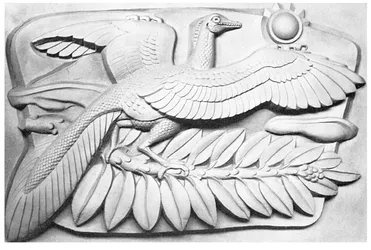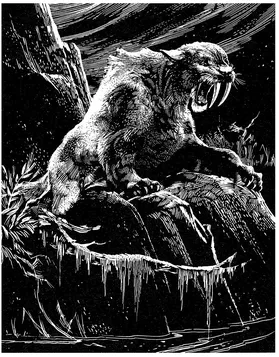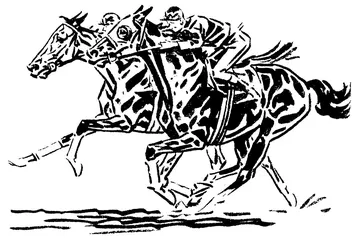
eBook - ePub
The Art of Painting and Drawing Animals
Fredric Sweney
This is a test
Partager le livre
- 200 pages
- English
- ePUB (adapté aux mobiles)
- Disponible sur iOS et Android
eBook - ePub
The Art of Painting and Drawing Animals
Fredric Sweney
Détails du livre
Aperçu du livre
Table des matières
Citations
À propos de ce livre
Thousands of years after man first recorded his impressions of animals on cave walls, artists are still attempting to reproduce images of these incredibly diverse creatures of land, sea, and air. This book by an award-winning artist is designed to aid painters at all skill levels to draw and paint wildlife with precision and accuracy.
Award-winning artist Fredric Sweney begins by using the horse as the basis for understanding the physical structure of animals, while the wild duck serves as the model for the configuration, wing construction, and flight characteristics of birds. More than 260 illustrations, along with step-by-step details, make it easier and more enjoyable than ever to paint a Noah's Ark of dogs, cats, oxen, deer, bears, birds, goats, and more exotic animals--in every size and shape.
An invaluable guide to zoological anatomy, ideal for beginners as well as advanced artists, this complete, practical reference will also serve as an excellent resource for resolving commonplace problems of artistic composition.
Award-winning artist Fredric Sweney begins by using the horse as the basis for understanding the physical structure of animals, while the wild duck serves as the model for the configuration, wing construction, and flight characteristics of birds. More than 260 illustrations, along with step-by-step details, make it easier and more enjoyable than ever to paint a Noah's Ark of dogs, cats, oxen, deer, bears, birds, goats, and more exotic animals--in every size and shape.
An invaluable guide to zoological anatomy, ideal for beginners as well as advanced artists, this complete, practical reference will also serve as an excellent resource for resolving commonplace problems of artistic composition.
Foire aux questions
Comment puis-je résilier mon abonnement ?
Il vous suffit de vous rendre dans la section compte dans paramètres et de cliquer sur « Résilier l’abonnement ». C’est aussi simple que cela ! Une fois que vous aurez résilié votre abonnement, il restera actif pour le reste de la période pour laquelle vous avez payé. Découvrez-en plus ici.
Puis-je / comment puis-je télécharger des livres ?
Pour le moment, tous nos livres en format ePub adaptés aux mobiles peuvent être téléchargés via l’application. La plupart de nos PDF sont également disponibles en téléchargement et les autres seront téléchargeables très prochainement. Découvrez-en plus ici.
Quelle est la différence entre les formules tarifaires ?
Les deux abonnements vous donnent un accès complet à la bibliothèque et à toutes les fonctionnalités de Perlego. Les seules différences sont les tarifs ainsi que la période d’abonnement : avec l’abonnement annuel, vous économiserez environ 30 % par rapport à 12 mois d’abonnement mensuel.
Qu’est-ce que Perlego ?
Nous sommes un service d’abonnement à des ouvrages universitaires en ligne, où vous pouvez accéder à toute une bibliothèque pour un prix inférieur à celui d’un seul livre par mois. Avec plus d’un million de livres sur plus de 1 000 sujets, nous avons ce qu’il vous faut ! Découvrez-en plus ici.
Prenez-vous en charge la synthèse vocale ?
Recherchez le symbole Écouter sur votre prochain livre pour voir si vous pouvez l’écouter. L’outil Écouter lit le texte à haute voix pour vous, en surlignant le passage qui est en cours de lecture. Vous pouvez le mettre sur pause, l’accélérer ou le ralentir. Découvrez-en plus ici.
Est-ce que The Art of Painting and Drawing Animals est un PDF/ePUB en ligne ?
Oui, vous pouvez accéder à The Art of Painting and Drawing Animals par Fredric Sweney en format PDF et/ou ePUB ainsi qu’à d’autres livres populaires dans Arte et Técnicas artísticas. Nous disposons de plus d’un million d’ouvrages à découvrir dans notre catalogue.
Informations
Sujet
ArteSous-sujet
Técnicas artísticasCHAPTER ONE

The first artist
FROM THE SLIMY, FOUL-SMELLING SWAMP of 250 million years ago, the amphibians, those sluggish creatures of the reptilian world, took their first tentative footsteps into the Paleozoic period. From this ancestral beginning the reptiles, birds, and animals had their birth. Humans did not appear until many millions of years later. The golden age of the dinosaurs lay ahead, but the first bird, Archaeopteryx, a magnificent, crow-sized, reptile-like creature with the beautiful feathers, already was here. (See Figure 1.1.)
During this era, when gigantic, cold-blooded, egg-laying vertebrates roamed the world, many warm-blooded creatures who bore their young alive and nursed them through infancy also inhabited this planet. The mammoth and the woolly rhinoceros searched for food, and they in turn were being hunted by the Neanderthal.
The sabre-toothed tiger (Figure 1.2) still prowled the land but, inexplicably, these giants—the mammoths, mastodons, and sabre-tooths—died quickly as the ice retreated toward the north, leaving the smaller animals, such as the rabbits, reindeer, and bison, to replenish and inhabit the earth.
The Cro-Magnon, who replaced the Neanderthal of the Stone Age 35,000 years ago, were successful in recording their impressions of the animals and birds of their time. Some of these illustrations are found on the walls and ceilings of the caves at Lascaux, Niaux, and Rouffignac in France, and at Spain’s Altimira Cave.
Figure 1.1
VIKTOR SCHRECKENGOST (American, 20th century)
Archaeopteryx (glazed colored terra cotta).
Courtesy of Viktor Schreckengost and the Cleveland Zoo, Cleveland, Ohio.

Culturally superior and intelligent, the Cro-Magnon set the pattern for contemporary families. Although they hunted most of the day in order to live, they still found time to produce beautiful art.
They endured extreme hardship and privation in a primitive and hostile land and environment. It is not surprising, then, that they would paint and sketch animals and birds that they hunted each day. Interestingly, very few human figures appeared in their art. The animals and birds were more important to them because they faced them daily when hunting for food.
The Cro-Magnon were very versatile in their art. In addition to the drawings, they made sculptures in the round and cut engravings into cave walls.
The sculptures give insight into Cro-Magnon life. These early humans are to be admired for the spark of intelligence that guided them into leaving their artistic mark on the walls of caves for posterity to learn from and enjoy.
The caves that served as homes were practically devoid of decoration. The great cave art that we know of today is restricted to the caves that had labyrinths of deep underground galleries and passages, and subterranean pools and rivers with colorful parades of stalactites and stalagmites. Since these caves were dark and mysterious, people had to carry torches or fat-filled stone lamps in order to enter them.

Figure 1.2
Sabre-toothed Tiger.
A large carnivore with long, cutting canine teeth; became extinct during the Pleistocene period.
Cave art depicting animals and wild game are at present the oldest graphic representation of form in the history of the human race.
Cave art does not exhibit any abstract, expressive forms of symbolic subjects, but these sketches and paintings are the masterpieces of Cro-Magnon, considering their limitations in terms of tools, equipment, and cramped working areas.
Lascaux was the most recent cave to be discovered, and it is without doubt the most interesting. A dog fell into a crack, and this accident led to the discovery of Lascaux. No one knows when the next cave might be found by a picnicker or a wandering animal seeking shelter. The cracking of a thin wall might also reveal the existence of additional caves. Some of the paintings are located in the worst possible places for viewing, behind rocks and in narrow niches.
What could have been the purpose of these out-of-the-way paintings? According to experts, this art provided a means of employing magic before a hunt.
Cro-Magnons were well equipped with all of the necessary weapons for a successful hunt, but in spite of all their powers and equipment they knew that they would face extremely dangerous animals that could cost them their lives. They also felt that if they painted pictures of the animals they wished to kill, this would forestall a tragic ending to a hunt.
Quite often primitive people would fabricate an enemy, an animal, or other game into a wall painting or clay sculpture in order to attack it physically in the hope that the real object itself would be injured or killed. To kill the game by throwing a spear toward the painted image would assure them of success in the forthcoming hunt.
Performing magic and religious rituals before the hunt was believed to magnify the power of the “wish picture.” The fact that more than one painting occupies the same space suggests that a new painting was not for display but was used for new magic for the next hunt.
This brings up the question: Were these paintings made by a single person within a community or were they made by more than one artist? After a study of these cave paintings the viewer is not aware of any obvious differences in technique or style.
Apparently, good wall space was at a premium since concentrations of paintings occupy certain favored areas, possibly because these spots were thought to have stronger magic.
Cave magic required magicians. There are more than fifty known pictures of dancing shamans that look like human figures dressed in animal skins, sometimes even with animal heads and antlers.
Increasing numbers of families and hunters, as well as seasonal migrations, resulted in a scarcity of game that caused Cro-Magnon to resort to additional hunting magic.
It is also conceivable that, in this language-less culture, the cave paintings served as technical illustrations used to instruct new hunters.
Since the cave art was not located near an entrance, these paintings were obviously not made for decorative purposes, and they were not thought of as “fine art” by their creators. Instead, they were magical weapons to ensure a successful hunt.
CHAPTER TWO

The horse
PORTRAYALS OF THE HORSE date back 35,000 years to the time when they were sketched on the walls of caves in France and Spain. The horse, with its magnificent grace, strength, and beauty, always has been a challenge for the artist.
HISTORY
If we trace the lineage of the horse back to its ancestral beginnings, we go back in time 55 million years to a twelve-inch-tall creature named Eohippus (“the dawn horse”). This small, four-legged, horse-like mammal with splayed four-toed forefeet and three-toed hindfeet wandered the forest floor of the Eocene epoch.
As the urge to run on the developing grasslands and savannas increased, the horse’s evolution raised it up onto its central toes. The side toes or digits slowly disappeared, leaving only vestigial evidence that they ever existed. The central toe evolved into the hoof.
The advent of the Ice Age had important effects on the development of the horse. Probably the most important phase of this chilling of the North American continent was the lowering of the level of global sea water caused by freezing. When the water level had been lowered by several hundred feet, a land bridge was formed between North America and Eurasia. This bridge made it possible for the primitive horses, which had developed in North America, to migrate to Eurasia. Eventually, with the drift of the continental land masses and the melting of the ice, the Bering Strait filled with water, and the horses that had completed the long journey gradually spread over all of Europe. The North American horse then became extinct during the Ice Age.
Historians are not certain where or when the first horse was domesticated, but apparently the nomadic tribes that wandered over the steppes about 2,000 years ago were instrumental in capturing, taming, and breeding horses from one corner of Europe to another.
The Assyrian artists were among the earliest to leave graphic evidence that the horse had been tamed and was being ridden.
Historians also have credited Columbus with being the first to bring cattle and good Spanish horses to Santo Domingo on his second voyage to America in A.D. 1493, thereby completing the circle—from North America to Eurasia and back again.
This animal still manages to survive in our modern, mechanized world, and there are today more than 100 breeds of horses and ponies. They come in all sizes, large and small, the heavyweights and the lightweights, the working horses and the domestics, along with the innumerable types of riding horses, the wild horses, the horses that are caught up in the social world of polo, the sportsmen’s matched bays, and the race horses with their brilliantly clad jockeys, just to name a few.
Dictionaries generally d...